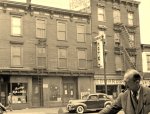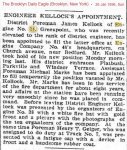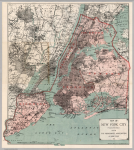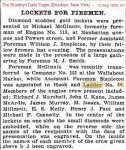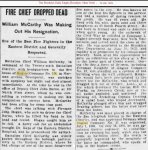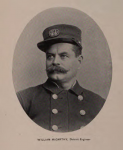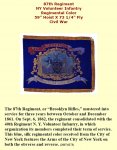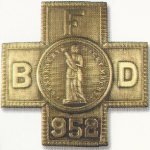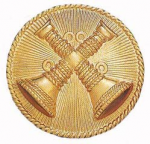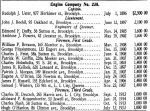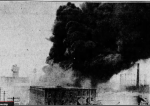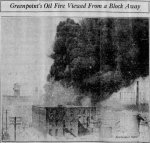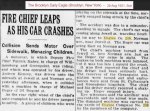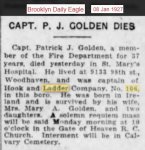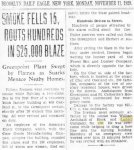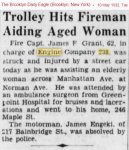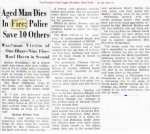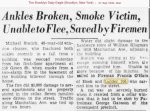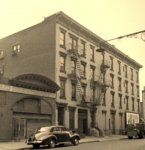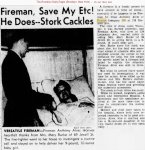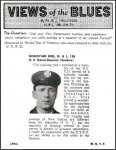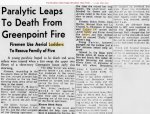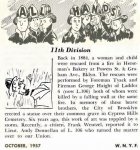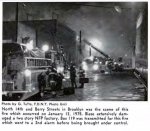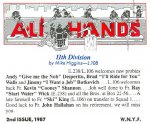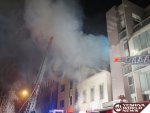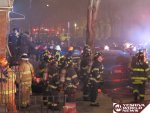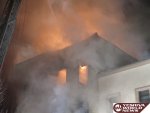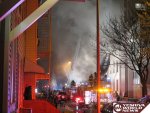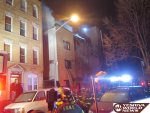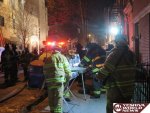ENGINE 238/LADDER 106/FOAM TENDER FIREHOUSE 205 GREENPOINT AVENUE GREENPOINT, BROOKLYN DIVISION 11, BATTALION 28 “GUARDIANS OF GREENPOINT” "TILLER TRUCK"
FIRES/INCIDENTS/EVENTS
2006 - 10 ALARMS

 FDNY 10-Alarmer Burns for 36 Hours
FDNY 10-Alarmer Burns for 36 Hours
A 10-alarm fire in Brooklyn, NY, destroyed a multi-building complex on May 2, 2006. The fire burned for 36 hours and required the response of land- and water-based equipment for several days.
Jul 1st, 2006
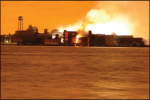
The fire rages almost 46 hours later as seen from Manhattan across the East River. On the first 10 alarms, 44 engines and 26 ladder companies responded. The complex was at one time the world’s largest manufacturer of marine rope. An FDNY fireboat was stationed alongside the complex at the East River for many years.
Michael Gomez
View Image Gallery
Brooklyn, NY, May 2, 2006 – A 10-alarm fire destroyed a multi-building complex along the East River in the Greenpoint section. The fire burned for several days and required the response of land- and water-based equipment. Except for the World Trade Center on 9/11, this was the largest fire in New York City since a 1996 fire in Brooklyn Height
FDNY 10-Alarmer Burns for 36 Hours | Firehouse
 FICKLE WIND SAVED B’KLYN ; INSIDE FDNY’S INFERNO DRAMA
FICKLE WIND SAVED B’KLYN ; INSIDE FDNY’S INFERNO DRAMA
By Brad Hamilton
May 7, 2006 | 4:00am
The whole neighborhood could have gone up in flames.
Had it not been for a rare easterly wind and decrepit buildings that gradually collapsed on themselves, the 10-alarm inferno at the Greenpoint Terminal Market on Tuesday might easily have engulfed a much larger swath, according to an FDNY chief’s post-mortem.
The first alarm sounded at 5:33 a.m.
The dilapidated brick warehouse just feet from the East River, 2 Noble St., was on fire.
Engine 238 and Ladder 106 sped from Greenpoint Avenue and arrived at 5:39 a.m., taking Noble Street almost to the water’s edge.
Some 20 firefighters rushed into the building.
The fire, which is considered suspicious, started inside, though it’s unclear exactly where or how. Fire marshals would not confirm reports that an accelerant was used to start the blaze.
Firefighters knew the terminal buildings had long been abandoned but worried that vagrants or squatters could be trapped inside.
No one was inside – but what they found was a nightmare.
The lofty three-story structure, pocked with holes in the roof and the walls and built with 19th-century heavy timber, was piled high with old bundles of rope and leftover merchandise.
It was the perfect tinderbox.
Minutes later, Marine Unit 6, a 52-foot fireboat called Kane, sped up the East River.
The boat squared up in front of 2 Noble St. at 5:49 a.m., preparing to unleash its dual pump hoses – each capable of shooting out 5,000 gallons of water per minute.
But the boat couldn’t nudge close enough or draft the river water it needed.
It was still low tide.
Another two rigs – Engine 229 and Ladder 146 – came barreling down the street to aid the first units. Together, the men unfurled two hoses and poured it on.
The chiefs hoped the firefighters could halt the blaze from spreading to taller buildings east in the complex.
Around that time, the tide had risen and the Kane unleashed a massive torrent on the fire.
“We set up for an interior attack,” said FDNY operations Chief Sal Cassano.
As the fire grew in an easterly direction, firefighters began to realize just how much it was being fed by the building’s flammable contents and the air pouring in from its many broken windows and shoddy roof.
As the flames spread to the building adjacent to 2 Noble St., two special operations units, Brooklyn’s Squad 1 and Queens’ Rescue 4, arrived on the scene and entered the second building to search for hazards.
They discovered the warehouse’s huge metal fire doors propped open.
It was impossible to tell how long the doors had been open, but the impact was the same. They would not help stop the spread of the fire.
“Those are recipes for a collapse,” said Cassano.
“The chiefs realized the need to pull out, so we started to set up for an exterior attack. Everything on the check list told them to get the heck out of there.”
The shift in strategy came after 6 a.m. The men got out just in time.
Inside 2 Noble St., the fire grew so hot it began to generate its own wind, driving the flames east, but also to the south, where there were more abandoned warehouses and where a new battlefront had to be opened.
Officials worried the fire might jump south across Oak Street to a cluster of three row buildings.
Tower Ladder 119, a 75-foot-tall beast with a bucket and stream capacity of 1,000 gallons per minute, worked its way west down Oak Street just after 6 a.m. It was looking to get as close as it could to the blaze and to try to act as a barrier – to block flames from jumping the street.
Oak Street, choked with debris and narrow, was tough to navigate.
Then the towering truck encountered a second-story brick overpass that connected the main complex to the three buildings to the south.
“The bridge was giving them trouble – they couldn’t get under it,” said Cassano.
Ladder 119 set up where it was, but was unable to quell the growing inferno. The fire was giving off such heat that a building south of Oak Street started to burn, even though the flames did not reach it.
Retreat was the only option. The call was made around 6:30 a.m.
Ladder 119, pinned between two walls of fire, backed up Oak Street. The four trucks on Noble Street also moved east toward the intersection of West Street.
Behind them, at Noble and West streets, three other engine companies and two ladder companies had set up a rear line of battle.
Groups of firefighters armed with heavy metal devices that act like water cannons, called stangs, were dispatched to adjacent buildings.
Three stangs were hauled into a building across Noble Street to the north and three more went into an abandoned parking garage across West Street to the east, where they opened up on a burning bridge.
As the fire grew, the chiefs ordered a second retreat at 7:45 a.m. The rigs on Noble and Oak streets rumbled east again toward West Street.
Burning embers were being carried as far as 1,000 feet away, endangering the Bayside Fuel Oil depot, just a few blocks to the south of the inferno.
At 8 a.m., Battalion 57 had moved into position to protect the depot and the rigs on Noble and Oak streets were called back to West Street.
Seventy companies from Brooklyn, Queens and Manhattan had arrived, amassing 350 firefighters.
Despite the manpower, “We realized the fire might take the whole complex,” Cassano said.
Since none of the seven buildings making up the main warehouse could be saved, the chiefs thought it would be best to let the fire burn itself out, Cassano said.
But they were worried it would continue to jump streets.
So they set up in force along West Street to defend a row of wood-frame homes just a block east.
“That was our Maginot Line,” said Cassano, referring to the line of fortification. “We made a stand there.”
The buildings then began to collapse. The one at 2 Noble St. went down at 8:41 a.m. Nine others gradually caved in and crumbled, though some only partially.
“They went in relative succession,” said Cassano. “That helped us.”
Only after the implosions did the inferno begin to cool. The firefighters were finally able to get at the source of the flames.
Meanwhile, winds were whipping toward the East River away from residents.
“Wind can be a friend or foe. In this case it was our friend,” said Cassano.
At 10:30, the last section in the main seven-building complex fell.
It came down right in front of the “Maginot Line,” just west of West Street.
“When that wall collapsed, we started to feel pretty good about the fire,” said Cassano.
Officially, the blaze would not be called “under control” until 5:11 p.m. Wednesday, 36 hours after it started.
ANATOMY OF A 10-ALARM FIRE – TIMELINE
TUESDAY, MAY 2
1. 5:33 A.M.
First alarm sounds that 2 Noble St. is on fire. Fire trucks rush to the abandoned Greenpoint terminal building.
2. 5:59 A.M.
Marine Unit 6 arrives, prepared to open up its two pumps, each capable of producing 5,000 gallons of water per minute, but is unable to produce a spray because of low tide.
3. 6 A.M.
The fire spreads east, helped by the dilapidated state of the building, and firefighters pull out to Noble Street.
4. 6:05 A.M.
A new front opens behind the building on Oak Street by Tower Ladder 119, a 75-foot structure with a bucket. The ladder is unable to pass the bridge connecting two of the buildings so it sets up next to it.
5. 6:20 A.M.
Buildings across Oak Street catch fire from the heat alone.
6. 6:30 A.M.
The heat and spreading flames require a partial retreat east toward West Street by all firefighters.
7. 6:45 A.M.
Water cannons are set up in buildings across Noble Street.
8. 8 A.M.
Battalion moves to protect the Bayside Fuel Oil depot a few blocks away.
9. 8:05 A.M.
A full retreat to West Street is ordered. There, a western front is established.
8:15 A.M.
2 Noble St. collapses, followed by nine other buildings, and eventually firefighters are able to move in and work on putting out the fire.
WEDNESDAY, MAY 3
5:11 P.M.
Fire is declared under control
https://nypost.com/2006/05/07/fickle-wind-saved-bklyn-inside-fdnys-inferno-drama/


